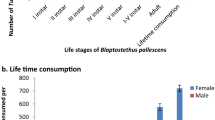Abstract
The present investigation was conducted to assess the favorable prey of different vermiform larvae of certain insects (Ceratitis capitata, Musca domestica) and phyto-parasitic nematodes (Pratylenchus zeae, Meloidogyne incognita var. 3) which would exterminated by the predator nematode,Diplogaster sp.
The obtained results indicate thatDiplogaster sp. exteriminated large numbers of prey ofM. incognita var. 3 andP. zeae, followed byC. capitata andM. domestica. The larvae of phytoparasitic nematodes were preferable prey toDiplogaster nematode, than that of insects. The predatious rate on the larvae ofM. incognita, P. zeae, C. capitata andM. domestica was 81.5, 76, 55, and 44%, respectively.
Zusammenfassung
Zwecks Untersuchung der Beutepräferenz und der Effizienz des räuberischen NematodenDiplogaster sp. wurden dessen Adulten mit den Larven zweier pflanzenparasitärer Nematodenarten (Pratylenchus zeae undMeloidogyne incognita var. 3) sowie mit den Larven zweier Fliegenarten (Ceratitis capitata undMusca domestica) zusammen gehalten.
Die Ergebnisse zeigen, daß dieDiplogaster-Nematoden einen großen Teil der Beutetiere fraßen, und zwar in der ReihenfolgeM. incognita, P. zeae, C. capitata undM. domestica. Die beiden phytoparasitären Nematodenarten wurden somit den Insekten-larven vorgezogen. Die Vernichtungsquoten betrugen in dieser Reinhenfolge 81,5-76-55 und 44%.
Similar content being viewed by others
Literaturverzeichnis
Boosalis, M. G.;Mankau, R., 1965: Parasitism and predation of soil microorganisms. In: Ecology of soil borne plant pathogens. ed.K. F. Baker, W. C. Snyder,6, 374–389. Berkeley: Univ. Calif Press. 571 pp.
Cohn, E.;Mordechai, M., 1974: Experiments in suppressing citrus nematode populations by use of marigold and predacious nematode. Nematol. Mediterr.2, 43–53.
Esser, R. P., 1963: Proc. Soil Crop Sci. Soc. Fla.23, 121–138. (C. F. Economic nematology Ed.J. M. Webter, 1972).
Goody, J. B., 1957: Laboratory method for working with plant and soil nematodes. Ministry of Agric. Fisheries and Food. Tech. Bull.2, London, 44 pp.
Hechler, H. C., 1963: Description, developmental biology and feeding habits ofSeinura tenuicaudata (de Man)J. B. Goody 1960 (Nematoda: Aphelenchoididae), a nematode predator. Proc. Helminthol. Soc. Wash.30, 182–195.
Osman, G. Y., 1988: Studies on the potential use of the predator,Diplogaster sp. (Nematodes, Diplogasteroidae) on certain root — parasitic Nematodes. Anz. Schädlingskde, Pflanzenschutz, Umweltschutz61, 70–73.
Mankau, R., 1980: Biological control of nematodes pests by natural enemies. Ann. Rev. Phytopath.128, 415–440.
Nelmes, A. J., 1974: Evaluation of the feeding behavior ofPrionchulus punctatus (Cobb), a nematode predator. J. Anim. Ecol.43, 553–565.
Oteifa, B. A., 1964: A toxonomic guide to the common genera of soil and plant nematodes with a supplement on current known economic parasitic species of U. A. R. Contrib. of the Nat. Res. Center Nematol. Unit. Giza. U. A. R.
Small, R. W., 1979: The effects of predatory nematodes on populations of plant parasitic nematodes in pots. Nematologica25, 94–103.
Stirling, G. R.;Mankau, R., 1977: Biological control of nematode parasites of citrus by natural enemies. Proc. Int. Soc. Citriculture3, 843–847.
Tanaka, N.;Steiner, L. F.;Ohinato, K., 1969: Low cost larval rearing medium for mass production of Oriental and Mediterranean fruit — flies. J. Econ. Entomol.62, 967–968.
Thorne, G., 1961: Principles of Nematology. McGraw Hill book Co; Inc. New York, 553 PP.
Yeates, G. W., 1969: Predation byMonchoides potohikus (Nematodes: Diplogasteroidea) in laboratory culture. Nematologica15, 1–9.
Author information
Authors and Affiliations
Additional information
Mit einer Tabelle
Rights and permissions
About this article
Cite this article
Osman, G.Y., Ghally, S.E. & Taha, M.A. Zur Wirkung verschiedener Beutearten auf die räuberische Kapazität des NematodenDiplogaster sp. (Rhabdita, Diplogasteridae). Anz. Schadlingskde., Pflanzenschutz, Umweltschutz 63, 65–67 (1990). https://doi.org/10.1007/BF01909003
Issue Date:
DOI: https://doi.org/10.1007/BF01909003




